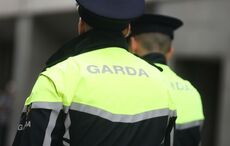The seventh skull to be excavated from Duffy’ Cut has no name, but it may soon have a face thanks to the offer of a local artist – Kristine Sullivan Strawser – to attempt a facial reconstruction.
In the fall of 1832, 57 Irishmen died – either of cholera or gunshot wound, or both – at Duffy’s Cut, a stretch of railroad line which was being constructed near Philadelphia, Pennsylvania. They had been brought over to work the railroad by one Philip Duffy, but within six weeks all were dead.
The local legends of their death had long interested Dr. Frank Watson. Upon the death of his grandfather, he inherited a large file of records that his grandfather’s former boss, an employee of the Pennsylvania Rail Company, had kept on the deaths of the 57 men.
Watson was, thereafter, hooked. He and his brother Bill, who is a professor of history at Immaculata University, have worked at the site from the beginning with a team of other historians and archaeologists.
Watson feels that this reconstruction will be a major step in the resolution of the Duffy’s Cut story.
“It puts a physical face to the story in a way the bare skulls won’t be able to provide,” he said in a telephone interview. “The facial bones are the most delicate and the other skulls had just deteriorated. One man’s jaw had fallen off.”
Watson believes that the history of Duffy’s Cut has a number of levels, including an emotional one.
“This is part of the human part of the story. We have names, where they came from, how old they were, but to get a face will be a big thing.”
The task of creating that face falls to Kristine Sullivan Strawser, a former journalist currently undertaking a postgraduate degree in art.
Strawser offered to recreate the skull. Or, in her words, “I imposed myself on these people and they were gracious in allowing me to impose.”
For Strawser, who is of Irish ancestry, this is as much personal as professional.
“I live not far from where the excavation is taking place,” she said. “I’d been hearing about it on the radio and I was most taken with it. My ancestors were moving around in the U.S. at that time.”
While Strawser does not have a forensic reconstruction background, she feels she can produce a good replica of the face of the man that the seventh skull used to be.
“I’ve done a fair amount of representational work and I feel confident I can get a reasonable reputation.”
Strawser intends to immerse herself in the research, finding as many renderings of Irish people from that era as possible, examining trends in clothing from the area of north west Ireland that the men came from, even finding out the likely effects of diet on the dead men.
“Nutrition is going to affect them and that’s something that’s absent from the bare skull. How hollow are the sockets of the eyes, what was the quality of the tissue on the face?”
She intends to work on this for as long as it takes, but feels that she can produce at least a first draft of the reconstructed face by year’s end.
“I’d like to get a critique from both a fine art people as well as folks from the anthropology area. It will be an ongoing process and I’d like to refine it over time.”
One of the people that Strawser will be dealing with is Janet Monge, a professor of anthropology at the University of Pennsylvania and the curator of the Duffy’s Cut bones. Like the Watson brothers, Monge has been involved in the Duffy’s Cut dig since the start.
With her science background, Monge is conflicted about the whole process, but is willing to give it a chance.
“It may be that the reconstruction will give certain familial similarities, rather than just looking like a northern European,” she said.
“It’s part science, part art. Because there’s clashing disciplines, some people see it as an accurate representation of a dead person, some people see it as a stab in the dark,” she said.
While the scientist in Monge is tempted to see this as an essentially pointless endeavour to create a face that will provide no substantive answers to the questions of the men’s lives or deaths, she also knows that sometimes this process can provide eerily accurate results.
“There was a case that I had worked on, human remainsin a skeletonised state. It was very difficult, but we had decided it was a murder. The person had a bullet lodged in them.”
“Frank Bender [a well-known forensic reconstructionist] did a full head reconstruction, which was photographed and circulated. A woman came forward who said it looked like her roommate, who had gone missing. They moved the body and found a key under the pocket of her pants. The key fit in the woman’s door.”
In the case of the men of Duffy’s Cut, there will be no way to verify if this is a true and accurate representation or not, but like Strawser and Watson, Monge knows that there’s more than just a scientific level to the Duffy’s Cut story.
“I think that when you’re dealing with skeletonised material, it’s important to get to the humanness … For a lot of people it’s very personal and I don’t think that’s harmful.”




Comments